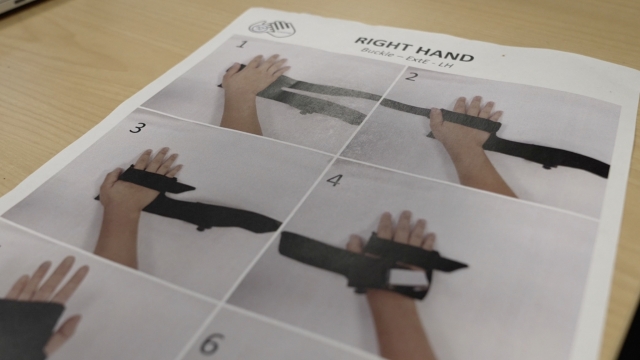Nearly 800,000 people in the United States have a stroke each year, according to the Centers for Disease Control and Prevention. A common challenge for stroke patients in recovery is spasticity, or severe muscle stiffness. Spasticity affects roughly a quarter of all stroke patients.
In the days following a stroke, a patient's muscles, especially in the arms and legs, are often weak and limp. Then a few weeks later, this involuntary stiffness sets in. It peaks at about three months after, and patients can get stuck in positions that hurt badly and lead to disability.
Researchers are testing vibrating technology to help patients get unstuck.
Ho Wei Tsang suffered a stroke in October of 2000 while in China. It left much of his left side paralyzed.
“They have a very good therapist and they teach me how to walk again. It’s very frustrating. But luckily I still have my right side,” he said.
He still deals with spasticity. The severe muscle spasms keep his arm stiff, his wrist chronically curved and his hand firmly in a fist.
Scripps News spoke with Stanford neurologist Dr. Maarten Lansberg, who both cares for stroke patients and conducts stroke research at Stanford and for the National Institutes of Health.
“You or I could open our hand if we want to. They can’t — even if they use their other hand,” said Landsberg. “We don’t know exactly what’s causing spasticity. To some extent the brain may not be even that involved. It may be a reflex that sort of goes through your spinal cord and causes this cramping up, and the spasticity of the hand and the leg. It’s a totally involuntary process.”
Lansberg and researchers at Stanford’s mechanical engineering CHARM Lab run by Professor Allison Okamura just published research on a medical glove to counteract spasticity.
“While we call it a glove, it’s not exactly a glove. And that’s on purpose, because a regular glove would be almost impossible for someone with spasticity in a hand to put on,” said Okamura.
It uses strategically placed motors to emit vibrations, similar to the buzz when your cellphone rings. The vibrations feel more intense than a tickle, lighter than a massage gun and come in different patterns. The technical term is vibrotactile stimulation.
“We always use the same amount, the same intensity of the vibration. But absolutely, you can kick it up and kick it down. You can also change the patterns of vibration, and maybe how intense it is on the palm versus another part of the hand,” said Okamura.
Right now, the standard of care for patients can include physical therapy, muscle relaxers, and Botox injections. They’re temporary, require routine clinical visits, and can get expensive.
In a clinical trial, stroke patients with spasticity used the vibrating glove. Researchers compared its effectiveness to Botox. Patients used the device three hours each day over 8 weeks before or after they had their standard Botox. The lab tested stiffness once a week.
“And we found that our device was as good as or better than Botox in the trial,” said Okamura. “I’m most excited about is how much it seems to have already impacted the lives of the participants that were in our clinical trials. Sometimes they don’t want to give us the glove back after they use it.”
One of those trial participants was Ho Wei Tsang.
“It’s like magic!. When I wear that and turn it on, I don’t know why but my muscle is soft completely,” said Wei Tsang.
So when can you get the product? Okamura says, “It’s far off to have a product that someone can just buy and or have their insurance pay for, but, we are hoping to run new clinical trials in the future where patients could potentially sign up to have access to one of the gloves.”
The hope is something could be available to patients in the next two to three years.
SEE MORE: Study: Many cancer drugs remain unproven after accelerated approval
Trending stories at Scrippsnews.com




